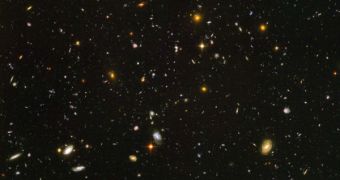Scientists with alloted observation hours on the Hubble Space Telescope (HST) have recently announced that they've photographed the most distant galaxies ever observed with a telescope. Shuttle Atlantis' mission to the orbit-based observatory translated into a new batch of cameras and scientific equipment, which considerably increased the telescope's power. The recently imaged galaxies offered a bit of a surprise to astronomers, in that they were neither as bright, nor as active, as stellar formations go, as they were expected to be, Wired reports.
The new study comes just days after the American space agency released the first scientific images taken with the famous Hubble, after the telescope spent months dealing with minor glitches and with cumbersome calibration processes. Even if not fully ready to snap photos just yet, its Wide Field Camera 3 (WFC3) was used to photograph the Pacific Ocean-size impact site on Jupiter, caused by a comet impacting the gas giant a couple of months ago.
The pictures that are only now being released are taken in infrared wavelengths, and were snapped between late August and early September this year. Although only preliminary analyses are in, and the numbers are estimative, the batch of galaxies that Hubble observed appears to be extremely far away. According to the research team behind the images, 16 of the galaxies reside some 12.9 billion light-years away from our solar system, while at least five are more than 13.1 billion light-years away, a record of insight into the early Universe.
“We are looking back 13 billion years and seeing galaxies just 600 to 700 million years after the Big Bang, when the Universe was like a 4-year-old,” University of California in Santa Cruz (UCSC) study member Garth Illingworth explains the team's excitement. All the galaxies have been photographed in the Hubble Ultra Deep Field, a small patch of the southern sky that had already been imaged by the famous telescope before, as well as by a large number of other observatories as well.

 14 DAY TRIAL //
14 DAY TRIAL //